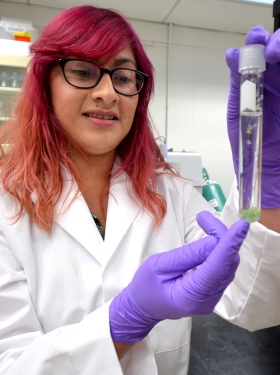On December 19, 2018, the Illinois Center for Specialized Professional Support hosted a Nontraditional Occupations (NTO) Summit at the Marriott Hotel and Conference Center in Normal, Illinois. The event took place in collaboration with the Illinois State Board of Education (ISBE) and the Illinois Community College Board (ICCB) and was fully funded by the Carl D. Perkins Career and Technical Education Act of 2006.
This all-day summit was led by two certified equity instructors from the National Alliance for Partnerships in Equity (NAPE) and attended by approximately 50 participants statewide who work with the Perkins Act in some capacity.
The presenters, Martina Sharp-Grier and Annissa Langworthy, led an interactive and engaging professional development workshop that focused on nontraditional fields (defined as “occupations or career fields in which people from one gender comprise less than 25 percent of the workforce”), factors that deter students from pursuing careers in these fields, as well as ways to increase participation and completion in CTE programs that lead to employment in these fields. Sharp-Grier and Langworthy related the importance of devising and utilizing strategies to increase participation, persistence, and completion in nontraditional programs (and ultimately nontraditional careers and occupations) to labor demands, particularly focusing on the increasing need for “middle-skill” workers and opportunities for upward mobility.
The group discussion throughout the day largely centered on how a lack of diversity, cultural and gender stereotypes, implicit bias, and micromessaging (i.e., microaggressions such as microinsults, microinequities, and microinvalidations) often serve as barriers that discourage students from considering the full range of careers and occupations available to them. Sharp-Grier and Langworthy highlighted the critical need for a diverse workforce in general and nontraditional careers specifically from a business, economic, and moral perspective. The speakers expressed the viewpoint that diversity drives innovation, yields economic growth, and fosters equal access and opportunities, especially among populations that are often underrepresented in certain gender or racially/ethnically dominated fields.
Additionally, the presenters encouraged and facilitated small-group discussions that were designed to demonstrate how cultural messages about who does certain kinds of work (i.e., “women’s work” versus “men’s work”) are reinforced and perpetuated. They provided examples of how these messages, along with the implicit bias that we all possess, as well as the manifestations of our implicit biases in the form of micromessages (defined as “small, subtle, unconscious messages”), impact students’ self-efficacy and, ultimately, their decision to pursue or not pursue nontraditional careers.
The session concluded with a poignant conversation about how individuals can transform behavior to effect positive change in the numbers of students entering nontraditional CTE programs and pathways, and subsequently nontraditional careers and occupations. Sharp-Grier and Langworthy outlined four key steps toward these objectives: 1) identify and address our own implicit biases; 2) build students’ self-efficacy through multiple avenues; 3) affirm and encourage the exploration of career pathways outside of gender norms; and 4) create equitable classrooms and school climates for every student to fulfill her or his potential. To begin this process, participants were encouraged to visit NAPEquity.org/IAT and take the Implicit Association Test, which measures a person’s implicit attitudes and beliefs.
Ultimately, this professional development workshop was interesting because of its primary focus on the real effects of stereotyping, implicit bias, and negative (and positive!) micromessaging on the career choices of students. It offered some simple individual behavioral changes that practitioners can make in their everyday interactions with students (starting with the recognition of one’s own biases) to positively affect their participation, persistence, and completion in nontraditional CTE program pathways and, ultimately, nontraditional careers and occupations.
